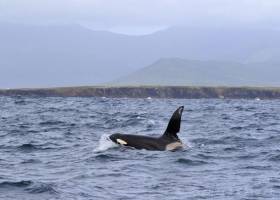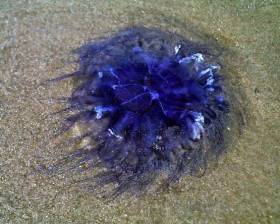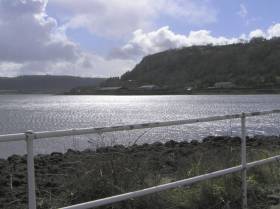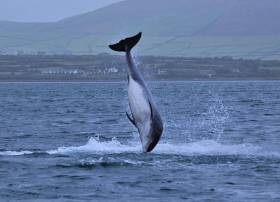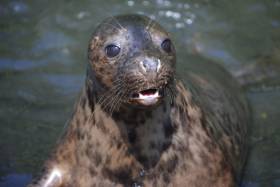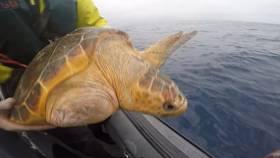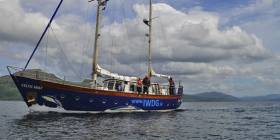Displaying items by tag: marine wildlife
Kerry Treated To Rare Sighting Of Killer Whale 'John Coe'
#MarineWildlife - Whale watchers on Slea Head were treated to a special sight earlier this week with the surprise appearance of the killer whale known as John Coe, as the Irish Examiner reports.
Landscape photographer Richard Creagh was among the lucky few on Monday (27 June) to spot the orca known by the distinctive notch on his dorsal fin – though in more recent times he's also lost a chunk of his tail fluke, most likely to a shark bite.
Creagh, a keen marine wildlife watcher for the last 10 years, said: "Up to now killer whales had always eluded me but today I got to add them to my list, and what a sight it was! I’m still buzzing!"
John Coe's unique orca pod are regular visitors to Irish waters, though he himself was last spotted close to our shores almost three years ago at the Inishkeas in Co Mayo, according to the Irish Whale and Dolphin Group – which is asking the public to watch the seas for any more sightings of the senior cetacean.
#Fishing - 'Money for old rope' is the pitch for a new initiative that aims to recycle old fishing nets that often end up littering the seas, as the Irish Examiner reports.
A number of Irish companies have been invited to Norway later this year to explore the possibility of collecting abandoned fishing nets and other ocean waste for repurposing in various industries – such as using the rope fibres in reinforced concrete.
They will be led by Macroom E, a company started by Cork County Council to help small and medium businesses make the most of recycling initiatives.
Macroom E is a partner with Circular Ocean, a Europe-wide project hosting a showcase this September on its work to remove waste from the ocean – where plastic and 'ghost nets' remain a hazard to marine wildlife – and turn it into a useful, and profitable, resource.
The Irish Examiner has more on the story HERE.
Jellyfish Warning For Sandycove Beachgoers
#Jellyfish - Dún Laoghaire-Rathdown County Council has raised the red warning flag in Sandycove and erected signs warning swimmers of the presence of stinging jellyfish in the water and washed up on the beach. Photographs have been taken and sent off for expert identification of the marine species.
Diesel Spill Threat To Wildlife In Larne Lough
#Larne - Coastal wildlife in Co Antrim is under threat after a significant diesel spill from a Caterpillar plant in Larne at the weekend, as the News Letter reports.
The plant machinery firm faces likely enforcement action after 40,000 litres of red diesel leaked into Larne Lough via a storm drain – news of which was not made public till days later, according to the Belfast Telegraph.
As the Northern Ireland Environment Agency moved to assure that the spill's impact on marine life would be minimal, conservationists remain concerned as the diesel slick was seen drifting towards The Gobbins, home to many protected seabird species.
Spot checks of affected parts of the Antrim coast have as yet found no injured birds, but Ulster Wildlife maintains that the spill "could have potentially devastating impacts on breeding birds".
The News Letter has more on the story HERE.
Wexford Blue Whale Held Together With Old Newspapers
#BlueWhale - The skeleton of a blue whale beached in Ireland that's to be the centrepiece of London's Natural History Museum has been held together by old newspapers for more than 80 years, it has emerged.
Afloat.ie previously noted the Irish origins of the giant marine mammal remains that were recovered from the Wexford coast 125 years ago – and is next year set to replace Dippy the diplodocus in the London museum's atrium.
But as Kent Online reports, it was only recently discovered that parts of the massive skeleton were being held together with copies of the Kent Messenger newspaper from the 1930s.
Staff responsible for the careful reconstruction of the blue whale specimen found dated newsprint within the plaster-like material that had been used as 'stuffing' to pack out and hold together its bones.
According to a museum spokesperson, it indicates strong connections between the English county and the workers in London who prepared the whale for display.
Kent Online has more on the story HERE.
Fungie The Dolphin Wounded By Propeller Blade
#Fungie - Dingle's resident dolphin Fungie has sustained a significant wound below his dorsal fin, as the Irish Examiner reports.
The deep cut, likely inflicted by a visiting boat's propeller, was noticed yesterday (Friday 3 June) by fans of the popular marine wildlife attraction who's delighted locals and visitors alike in Dingle for more than 30 years.
However, Fungie lovers have been urged not to panic – as the famous bottlenose has healed well from similar injuries before, and has already returned to frolicking with boaters in Dingle Harbour.
The Irish Examiner has more on the story HERE.
#BowheadWhale - The search continues in tracking down the elusive bowhead whale that's excited marine wildlife experts since it was sighted in Carlingford Lough at the weekend.
One of a species never before recorded in Irish waters in the 25 years since the Irish Whale and Dolphin Group (IWDG) was formed, the 20ft juvenile whale was photographed from a pilot boat at the mouth of the lough at the Helly Hunter Rocks on Sunday 29 May.
It's thought that it may be the same individual from the arctic species spotted off Cornwall in mid May, following a previous bowhead sighting at the Scilly Isles in February.
The Celtic Mist joined the hunt yesterday (Tuesday 31 May) on its circumnavigation of Ireland and failed to make any sighting, though bowhead whales are known for being difficult to spot due to their lack of a dorsal fin.
The IWDG has much more on this story HERE.
'Poison Ivy' Returns To The Wild At Salthill Beach
#MarineWildlife - Months after she was found on the streets of Galway, the seal pup named Poison Ivy has returned to the sea at Galway Bay with a group of fellow rescued seals.
As previously reported on Afloat.ie, Ivy was no more than three weeks old when she was picked up by council workers on a Salthill footpath last December.
Though seriously ill, she fought her way back to health under the watchful eye of the staff at Seal Rescue Ireland in Wexford, who gave her a name in keeping with their comic-book theme.
But it was back to Salthill she went this past weekend when Ivy was released into the wild at Ladies Beach, according to Galway Bay FM.
#Turtles - Two rescued loggerhead turtles have been returned to the ocean by the crew of LÉ Róisín as the Naval Service vessel makes its way to the Mediterranean on deployment.
According to RTÉ News, the Naval Service were only happy to oblige when contacted by Dingle Oceanworld about the possibility of releasing Una and Tallula.
The former was nursed back to health at the Dingle marine wildlife sanctuary after she was found at Barryroe in West Cork last December.
LÉ Róisín releases rescued turtles while en route to Mediterranean (Vid:Irish Naval Service) https://t.co/yyrasAbj23https://t.co/xJ8iSENsdr
— RTÉ News (@rtenews) May 5, 2016
She was joined on the OPV by Tallula, a turtle washed up in Cornwall who was treated at Newquay's Blue Reef Aquarium and flown into Dingle especially for release.
As previously reported on Afloat.ie, LÉ Róisín and its 57-strong crew are headed to the Mediterranean as the first deployment for the Naval Service this year under Operation PONTUS.
#MarineWildlife - Places are going fast for a special cruise on board the Irish Whale and Dolphin Group's Celtic Mist to celebrate the 25th anniversary of Ireland's whale and dolphin sanctuary.
Celtic Mist will depart Fenit, Co Kerry next Saturday 7 May with a team of IWDG members and marine science experts on an almost three-month circumnavigation of Ireland, first heading north along the Wild Atlantic Way and around to the Irish Sea, calling on Dublin on 7 June to mark the 25th anniversary of the Irish Government's official declaration of this island's waters as a sanctuary for cetaceans.
The declaration came only three months after it was proposed by the then newly formed IWDG, and both have been instrumental in raising awareness of the bounty of marine wildlife in Irish waters.
Though berths on the voyage are filling fast, everyone will have the opportunity to participate by assisting in outreach events along the cruise route, or by tracking its progress online. Details on how to get involved can be found on the IWDG website HERE.
Along the way passengers on Celtic Mist may be treated to some of the incredible wildlife the sanctuary was created to protect, such as humpback whales – a number of which were spotted on an early visit to West Kerry earlier this month, likely attracted by schools of sand eels, as the IWDG reports.
In other marine wildlife news, locals near a beach close to Ballyshannon in Co Donegal have complained after a whale carcass was left rotting on rocks three days after it was reported to authorities.
According to the Irish Mirror, successive high tides had failed to shift the 25ft minke whale, though Donegal County Council says it is arranging for the animal's disposal.


























